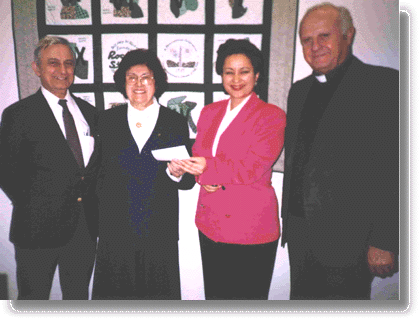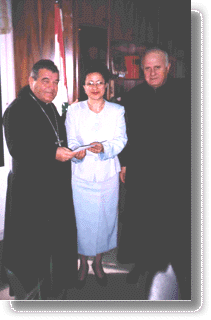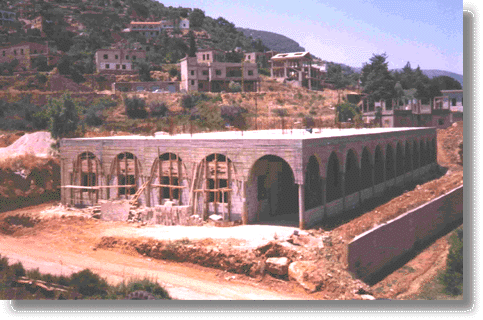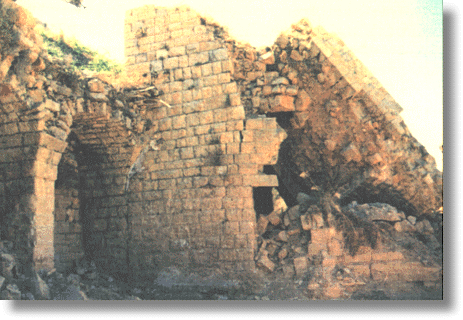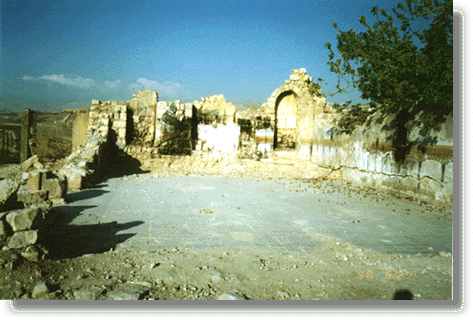By Guita G. Hourani
"Inasmuch as you have done it for one ofthese the least
(Ms. Brice gave us permission to identify her and disclose her donation when we said that her example might inspire others to help Christians in Lebanon rebuild their churches and sacred sites devastated by the war. She was convinced that more good would be accomplished by not remaining anonymous and by allowing her photograph to be taken.)
On March 10, 1999, Ms. Manell P. Brice, a member of the Journal of Maronite Studies' Editorial Board made a $3,000 contribution through The Maronite Research Institute toward therebuilding of churches partially orcompletely destroyed during the war in Lebanon. These churches are three in the Shouf Mountain, three in the Bekaa Valleyand one in the North. The churches in the Shouf were completely razed and were the sites of massacres, the ones in the Bekaawere destroyed during the war. Ms. Brice is contributing to on-goingrebuilding efforts by the parishioners ofthese villages. She was heartbroken toknow that many of the destroyed churcheshave still not been rebuilt. She recognizedthat church is the heart and backbone ofour communities. She also knows howimportant the church is in our tradition,being a monastic community, we gravitatetoward our holy places and support and protect them. Once the churches are rebuilt, the displaced may hope to return: "...if we build it, they will come." To this end, the donation went to assist in the rebuilding of Saint George's Church in Sareene, Saint George's Church in Nahr Barada, and Saint Elias' Church in Taalabaya in the Bekaa Valley; and the churches of Saint Anthony the Great in the Fouwara, Saint Challita (Artheme) and Saint Anthony in Chartoun in the Shouf region. A small donation was made to the Church of Our Lady in Bekaa-Kafra to assist in the restoration under way for its 75th Jubilee. His Excellency Mounjed Al-Hashem, Maronite Bishop of Baalbeck, accepted the donation to the churches prior to the feast of Saint George on the 23rd of April. The Churches of Saint George in Sareene and in Nahr Barada both were destroyed. Upon the enthronement of His Excellency Bishop Al-Hashem as bishop of Baalbeck, he began to revitalize the Christian communities of the Valley and to mobilizehuman and material resources to rebuild destroyed churches. The contribution of Ms. Brice raises hope that other people care and believe that these churches should be rebuilt.
The churches in the Bekaa are under tremendous pressure due to the social and demographic changes that occurred because and during the war. These churches struggle to maintain themselves as witnesses to Christianity in an increasingly unfriendly environment. These churches need prayers, moral support, and encouragement just as much as they need the financial support of our people. Ms. Brice was touched and humbled that her gift could spread so far and reach "so many unknown who defended Christianity, even at the cost of death...". His Excellency's message of gratitude has been shared with many of Ms. Brice's family, friends and relatives. The Church of Saint Anthony the Great was built toward the end of the last century. Next door was a small elementary school which had always been managed by the parish priest to serve the local children. In 1983, the inhabitants of Fouwara were uprooted and displaced and many of its elderly people who could not run away fast enough were martyred. Homes, church and school were leveled to the ground. Ten years after the massacre, the inhabitants of Fouwara returned and began rebuilding their village. They decided to build a new and bigger church with a school, a house for the priest, halls for celebrations, and social and cultural activities; offices for religious associations and other pastoral needs, a playground, and parking.
The Church of Saint Challita (Artheme) in Chartoun was built in the XVI century. Besides is value architecturally and historically, it has served as a meeting place for generations of the villagers. In 1983, when it was destroyed, 55 Syriac manuscripts and the icon of its patron saint were also destroyed along with its parochial school, two monasteries and the rest of the village homes. Surrounded with pine trees, Saint Anthony's church in Chartoun was also destroyed in 1983. It was built in the 1950s on the outskirts of the village in a place called Marj Chartoun. As well as being the witness to all the death and devastation, the trees are witnesses to Chartoun's resurrection and rebuilding.
The Church Committee of Chartoun wrote the following to Ms. Brice: "Your welcome donation will undoubtedly contribute to financing our already launched rebuilding project of Saint Challita's Church and for the preparation of the reconstruction plans of Saint Antoniusí Church in the village of Chartoun in the Caza of Aley-Mount Lebanon. The two Maronite Churches were totally destroyed in 1983 due to the hardhearted Lebanese war, a fate that was suffered and equally shared by all the village constructions, infrastructure and agriculture resulting in the population deserting the village and fleeing to safer areas in East Beirut. Of the inhabitants of the village who refused to leave their homes, 36 of them were killed atrociously. Today the village is having a rebirth. With the inhabitants' return to their native land and with the generous donations like yours we are able to rebuild our homes, churches, institutions and infrastructure. Once again we give you our sincere thanks and gratitude for your generous donation. God be always with you." Ms. Brice's donation to the churches in Lebanon is a reflection of her faith that all can and will be rebuilt for the return of the Christians displaced from their ancestral villages. In her own words, her love for God and her ancestral land and people is greater than any amount of money. And, in fact, she only gave us permission to disclose her donation when we said that hers was an example we desperately needed to inspire others everywhere to reach out across thousands of miles to our beloved fellow Christians in Lebanon as they rebuild their churches devastated by war.
As the Maronite Research Institute calls upon all those who believe that Christianity should persevere in the East, that our church bells should continue to ring, that our people must be able to enjoy their religious rights, it asks your support in these brave efforts to rebuild churches, parochial schools, and monasteries. Christians in the East need all your spiritual and moral support in order to survive in hostile and threatening environments and to continue to courageously follow Christ. It should be noted that in all these villages where Christians and non-Christians had lived side by side, there have as been efforts to reconcile and to begin anew in the spirit of peace, mutual rights and conviviality. For those of you who wish to contribute to the rebuilding of destroyed churches in Lebanon, you may send your tax deductible contribution to MARI at the following address: The Maronite Research Institute (MARI)
Please state in the memo that the contribution is for the destroyed churches. MARI will send you a letter of acknowledgment and the church to which the contribution was sent will also write to you. Please specify the region or village in Lebanon to which you want your contribution sent. MARI is a non-profit organization registered in the States under 501 ( c ) ( 3 ) with a tax exemption available upon request. We must use the words of Gibran Khalil Gibran and tell Ms. Brice: "The coin which you drop into the withered hand stretching toward you is the only golden chain that binds your rich heart to the loving heart of God" (Secrets of the Heart, 1947, p. 345). |
